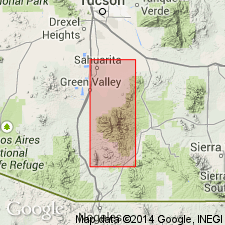
- Usage in publication:
-
- Elephant Head Quartz Monzonite*
- Modifications:
-
- Named
- Geochronologic dating
- Dominant lithology:
-
- Quartz monzonite
- AAPG geologic province:
-
- Basin-and-Range province
Summary:
Named for Elephant Head in the Santa Rita Mountains, Pima and Santa Cruz Cos, AZ, in Mount Wrightson quad. Elephant Knob is the type area. Is in two stocks in west-central Santa Rita Mountains. A coarse-grained quartz monzonite. Two K-Ar ages on biotite are 68.2 +/-2.4 Ma and 69.0 +/-2.1 Ma. A Pb-alpha age on Zr is 188 Ma. This anomaly may suggest that the unit was initially the Juraasic Squaw Gulch Granite [See Note Below] and was completely recrystallized during the Late Cretaceous. Is assigned a Late Cretaceous age.
[NOTE: In accordance with Department of Interior's Secretarial Order 3404, discontinuing use of derogatory term squaw, the Squaw Gulch Granite is in process of being formally renamed Santa Rita Gulch Granite (RESERVED). The geographic feature Squaw Gulch, from which the geologic name was taken (this report), was renamed Santa Rita Gulch by U.S. Board on Geographic Names, September 2022, USGS GNIS FeatureID 638662.]
Source: Modified from GNU records (USGS DDS-6; Denver GNULEX).
For more information, please contact Nancy Stamm, Geologic Names Committee Secretary.
Asterisk (*) indicates published by U.S. Geological Survey authors.
"No current usage" (†) implies that a name has been abandoned or has fallen into disuse. Former usage and, if known, replacement name given in parentheses ( ).
Slash (/) indicates name conflicts with nomenclatural guidelines (CSN, 1933; ACSN, 1961, 1970; NACSN, 1983, 2005, 2021). May be explained within brackets ([ ]).

